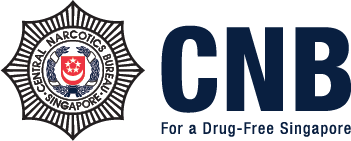Misuse Of Drugs Act (wef 1 May 2017)
28 April 2017
With effect from 1 May 2017, the Central Narcotics Bureau (CNB) will be listing all four New Psychoactive Substances (NPS)[1] currently in the Fifth Schedule of the Misuse of Drugs Act (MDA) in the First Schedule of the same Act. This means that these substances will be reclassified as Class A controlled drugs (see Annex A for the list of drugs). CNB will also be listing one new psychoactive substance commonly known as U-47700[2] in the First Schedule as a Class A controlled drug (see Annex B).
Following the listing of the five NPS as Class A controlled drugs, the trafficking, manufacture, import, export, possession or consumption of these substances will constitute an offence under the MDA. Any person found guilty of trafficking Class A controlled drugs will face a minimum of five years’ imprisonment and five strokes of the cane. They will also be liable for enhanced penalties if they re-offend or sell to young or vulnerable persons. CNB will also be empowered to subject NPS abusers to supervision, commit them to a drug rehabilitation centre for treatment and rehabilitation, or charge them in court.
CNB will be listing nine new substances in the Fifth Schedule of the MDA (see Annex C). This enables CNB to seize these NPS so that their circulation can be restricted while research and industry consultation are conducted.
Global NPS Situation
There has been a rapid increase in the number, type and availability of NPS across the globe. Based on a report released in November 2016 by the World Health Organisation Expert Committee on Drug Dependence, there were at least 730 NPS identified in 2016[3].
Many of these NPS have been reported in overseas journals to have no licit medical use. Their abuse has been linked to adverse physical and psychological reactions, including paranoia, seizures, hallucinations and even death. The listing of new NPS in the Fifth Schedule of the MDA is a necessary pre-emptive move to restrict the circulation of these harmful substances in our community.
CENTRAL NARCOTICS BUREAU
28 APRIL 2017
[1] New psychoactive substances (NPS) refer to substances which produce the same (or similar) effects as controlled drugs such as cannabis, cocaine, “ecstasy”, methamphetamine or heroin.
[2] The NPS U-47700 was listed to Schedule I of the Single Convention on Narcotics Drugs 1961 in March 2017 by the Commission on Narcotics Drugs. Schedule I substances are those with properties that might cause dependence and present a serious risk of abuse. As a signatory to the Convention and noting that U-47700 is a NPS with no licit use, Singapore is listing U-47700 in Schedule I of the MDA as a Class A controlled drug.
[3] Thirty-Eighth Report of the WHO Expert Committee on Drug Dependence
Reference:
The Fifth Schedule of the MDA was first enacted on 1 May 2013 to allow CNB to control and prevent the proliferation of NPS. NPS can be temporarily listed in the Fifth Schedule for up to 12 months, with a possibility of extension for another 12 months. The Fifth Schedule enables CNB to seize these NPS so that their circulation can be restricted while research and industry consultation are conducted. These processes are necessary before a substance is classified as a controlled drug. The trafficking, manufacture, import, export, possession or consumption of any substance, which is temporarily listed in the Fifth Schedule, will not constitute an offence under the MDA, until that substance is listed as a controlled drug in the First Schedule.
Annex A
The Fifth Schedule Drugs Relisted to the First Schedule as Class A Controlled Drugs (With effect from 1 May 2017)
5-Fluoropent-1-yl-N-naphthalen-1-yl-1H-indole-3-carboxamide (also known as CBM-2201, 5-Fluoro-NNEI, 5F-NNEI or MN-24F) and its fluoro positional isomers in the pentyl group
Methyl 2-[1-(cyclohexylmethyl)-1H-indole-3-carboxamido]-3,3-dimethylbutanoate (also known as Methyl N-{[1-(cyclohexylmethyl)-1H-indol-3-yl]carbonyl}-3-methyl-L-valinate or MDMB-CHMICA)
Naphthalen-1-yl 5-fluoropent-1-yl-1H-indole-3-carboxylate (also known as NM-2201 or CBL-2201) and its fluoro positional isomers in the pentyl group
Naphthalen-1-yl[1-(pent-1-yl)-1H-indazol-3-yl]methanone (also known as THJ-018)
Annex B
Substance Listed to the First Schedule as Class A Controlled Drug (with effect from 1 May 2017)
3,4‐Dichloro‐N‐[2‐(dimethylamino)cyclohexyl]‐N‐methylbenzamide (also known as U-47700) and its dichloro positional isomers in the phenyl ring and diamino positional isomers in the cyclohexyl ring
Annex C
New Substances Listed in the Fifth Schedule (with effect from 1 May 2017)
The following compounds, including any salt or stereoisomeric form of such compounds, and any preparation or product containing such compounds:
N-(1-Amino-3,3-dimethyl-1-oxobutan-2-yl)-1-(4-fluorobenzyl)-1H-indazole-3-carboxamide (also known as ADB-FUBINACA) and its fluoro positional isomers in the phenyl ring
N-(1-Amino-3,3-dimethyl-1-oxobutan-2-yl)-1-pentyl-1H-indole-3-carboxamide (also known as ADBICA)
N-(1-Amino-1-oxo-3-phenylpropan-2-yl)-1-(cyclohexylmethyl)-1H-indazole-3-carboxamide (also known as PX-3 or APP-CHMINACA)
1-Benzyl-4-methylpiperazine (also known as methylbenzylpiperazine or MBZP)
2-Bis(4-fluorophenyl)methylsulfinyl-N-methylacetamide (also known as N-methyl-4,4-difluoromodafinil or modafiendz) and its fluoro positional isomers in the phenyl rings
2-(4-Chloro-2,5-dimethoxyphenyl)ethanamine (also known as 2C-C) and its chloro and dimethoxy positional isomers in the phenyl ring
Methyl 2-[1-(4-fluorobenzyl)-1H-indazole-3-carboxamido]-3,3-dimethylbutanoate (also known as MDMB-FUBINACA) and its fluoro positional isomers in the phenyl ring
4-Fluoromethylphenidate and its fluoro positional isomers in the phenyl ring
Methyl 2-[1-(5-fluoropentyl)-1H-indazole-3-carboxamido]-3,3-dimethylbutanoate (also known as 5-Fluoro-MDMB-PINACA or 5-Fluoro-ADB) and its fluoro positional isomers in the pentyl group
